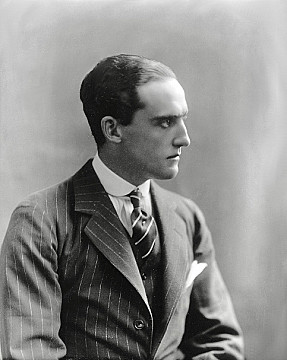Andrew Hamilton Gault (1882-1958)
Brig. A. Hamilton Gault, M.P., D.S.O. of Hatch Court & Mont Saint-Hilaire, Quebec
He was born in Montreal and was educated at Bishop's College School, Lennoxville, and McGill University. Rather than study science in England at Oxford, he joined the 2nd Royal Canadian Dragoons and served with distinction in the Boer War. Unsuccessful in his attempt to join a British Cavalry regiment, he returned to Montreal and resigned himself to working for the family business, manufacturing cotton. Nonetheless, he was an active member of the militia as a Captain in the Royal Highland Regiment of Canada; took every opportunity he could to go canoeing and fishing in northern Quebec; safaried in Africa; shot mountain goats in the Rocky Mountains; and, flew his biplane over Europe, Northern Africa and the Middle East.
In contrast to the likes of Charles C. Ballantyne, on the eve of the World War I he offered the Canadian government $100,000 to raise, equip and command an infantry battalion for overseas duty. Lt.-Col. Francis Farquhar of the Coldstream Guards, military secretary to Canada's Governor-General, the Duke of Connaught, supported Gault's idea. Between them, they made the decision to recruit men who had already seen military action but were not attached to any militia units in order to hasten the regiment's departure for Europe. The Governor-General's daughter, Princess Patricia (well known for her love of Canada and who got engaged at J.K.L. Ross' fishing lodge in Nova Scotia) was said to have been delighted when she was asked to be Colonel-in-Chief of Gault's regiment, designing and making the regimental flag herself by hand. Princess Patricia's Light Infantry (still operational today) was the first Canadian regiment to arrive on French soil.
In December, 1914, the Patricias arrived in France with 1098 men. By May 7, 1915, they were down to 635 men and by the end of the next day just 150 remained. Gault and Lt.-Col. Agar Adamson who led the regiment at Vimy Ridge and Passchendaele were the regiment's only two officers out of the original 30 to survive the war. Gault was wounded three times and lost a leg at Sanctuary Wood, but he refused repatriation to Canada. One officer said, "with ('Hammie') there, nobody could think of retiring... it gave everyone a tremendous lot of courage that nobody else in the world could give to the other regiments".
He inherited $1.3-million when his father died in 1903 and in the following year he married Marguerite Stephens, of Montreal. They were divorced in 1918 when he became suspicious that while he was recovering from his wounds she was having an affair with a younger officer in his regiment. She claimed it was merely a harmless flirtation and many who knew her well, agreed. In 1920, his fiancée, Mrs Kathleen (Newberry) Blackader (widow of his cousin and a fellow officer in the Patricias) died when he flipped the car he was driving. She was trapped underneath, and he was unable to free her.
In 1922, he married Dorothy Blanche Shuckburgh and bought Hatch Court in Somerset (see images) from her aunt. His military record helped ensure his election as a Member of Parliament for Taunton between 1924 and 1935, but in 1945 they returned to Canada where they lived on his 2,200-acre estate at Mont Saint-Hilaire in Quebec. He died without children, and having successfully fought off all attempts to expropriate his land for mining, he bequeathed the estate to McGill University for its lasting prosperity. He was given a military funeral with full honours at Montreal and is buried at Hatch Court.





